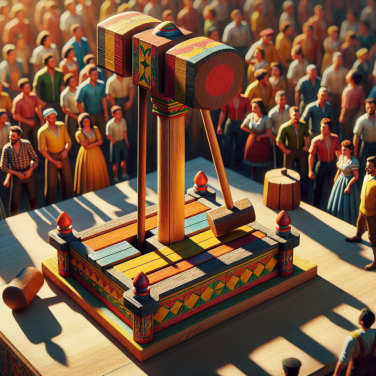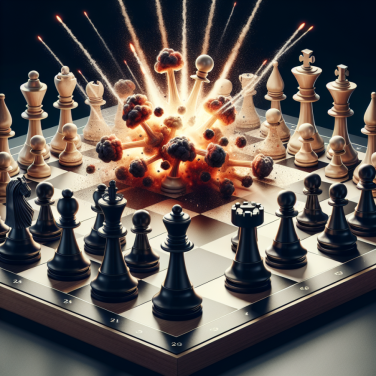Unveiling the Aggressive Playbook of Atomic Chess Masters
In the world of Atomic Chess, the stakes are high and the plays are explosive—literally. This variant diverges starkly from traditional chess with one twist: when a piece is taken, an 'atomic explosion' occurs, wiping out all surrounding non-pawn pieces, including sometimes the pieces of its own color! This unique rule drastically alters the strategic landscape, and the masters of Atomic Chess employ aggressive and intricate tactics that would seem bizarre in the context of conventional chess.
Central to the Atomic Chess strategy is the concept of controlled chaos. With each capture potentially leading to a wide-ranging clear-out, masters leverage this to create double-edged positions where the threat of detonation looms large. In these situations, the standard principles of material advantage often give way to positioning and pattern recognition.
One key strategy is the deliberate sacrifice of pieces to dictate the pace of the game. By offering up a piece, a skilled Atomic player can bait an opponent into an unfavorable explosion or create weaknesses in the opposing camp. This is not limited to minor pieces; even queens can be offered if the resulting explosion disrupts the opponent's king safety or leads to a decisive follow-up.
Another facet of the Atomic Chess arsenal is the use of pawns as defensive shields. Since pawns are immune to the atomic explosions, placing them strategically around more valuable pieces can provide necessary cover. Masters craft pawn structures that not only defend their major pieces but also threaten to burst into the opponent's territory, exploiting the unique capture rule.
The middle game in Atomic Chess often centers around developing a 'threat network,' a web of interconnected potential captures where one move could set off a chain reaction. The positioning of pieces is not just about controlling spaces but about creating and avoiding potential explosions. Atomic Chess masters are adept at identifying these networks and manipulating them to their advantage.
The endgame scenario in Atomic Chess is starkly different from its traditional counterpart. With far fewer pieces on the board, the danger of explosions decreases, but the importance of swift, precise maneuvers increases. One false step can lead directly to checkmate, as the usual buffers (other pieces) are often not present.
In this environment, timing is crucial. The aggressive play often observed in the opening and middle game transitions into a delicate dance, where the mastery lies in forcing the opponent into a vulnerable position without viable moves.
Read also:
Slapshots and Strategies: Unveiling Ice Hockey's Dynamic Tactics
Deciphering the Tactical Nuances of Atomic Chess
In the enthralling world of Atomic Chess, traditional strategies undergo a radical transformation as players must adapt to the unique explosive twist inherent in this variant. A single capture has the potential to dramatically alter the board's landscape, resulting in a heightened emphasis on tactical foresight and precision.
Positional Play and Pieces Value: In Atomic Chess, position is king, but not in the traditional sense. The value of each piece is recalibrated considering the explosive potential; thus, a knight or a bishop placed near the opponent's king or other structurally significant pieces may far exceed the orthodox value assigned to queens or rooks. Understanding and exploiting these shifting values by placing pieces on key squares can be the difference between victory and defeat.
Control of the Center: The center squares gain even greater importance in Atomic Chess. Controlling these squares not only grants you increased mobility but also the potential to launch devastating attacks. The strategic placement of your pieces within or near the center can threaten multiple enemy pieces due to the cascading effect of the explosions.
Piece Coordination and Sacrifice: Coordinating your pieces to support one another is a delicate operation, given that one wrong move can result in collateral damage. Artful sacrifice becomes a powerful stratagem, potentially dismantling your opponent's defensive structure or even leading directly to checkmate if the sacrificed piece is adjacent to the enemy king. Determining the optimal time to execute such sacrifices requires a deep understanding of both the current board position and your opponent's potential responses.
Attack and Defense: Launching an attack in Atomic Chess often revolves around the aforementioned sacrifices and feints. An attacker typically aims to coerce the defender into an unfavorable capture that could trigger an explosion advantageous to the attacker. Defense, in contrast, involves not only protecting your pieces but also ensuring that no capture on your side can lead to a catastrophic chain reaction.
King Safety: In standard chess, a well-fortified king with pawn shields is vital for survival; however, in Atomic Chess, that very strategy can be a double-edged sword. Since pawns can become liabilities if exploded, they must be positioned cautiously. Sometimes it is safer for the king to remain mobile and even somewhat exposed rather than encircled by pieces that could spell its doom if detonated. Recognizing the balance between a secure yet flexible king position is paramount.
Endgame Considerations: The endgame scenario in Atomic Chess is drastically different from classical chess.




